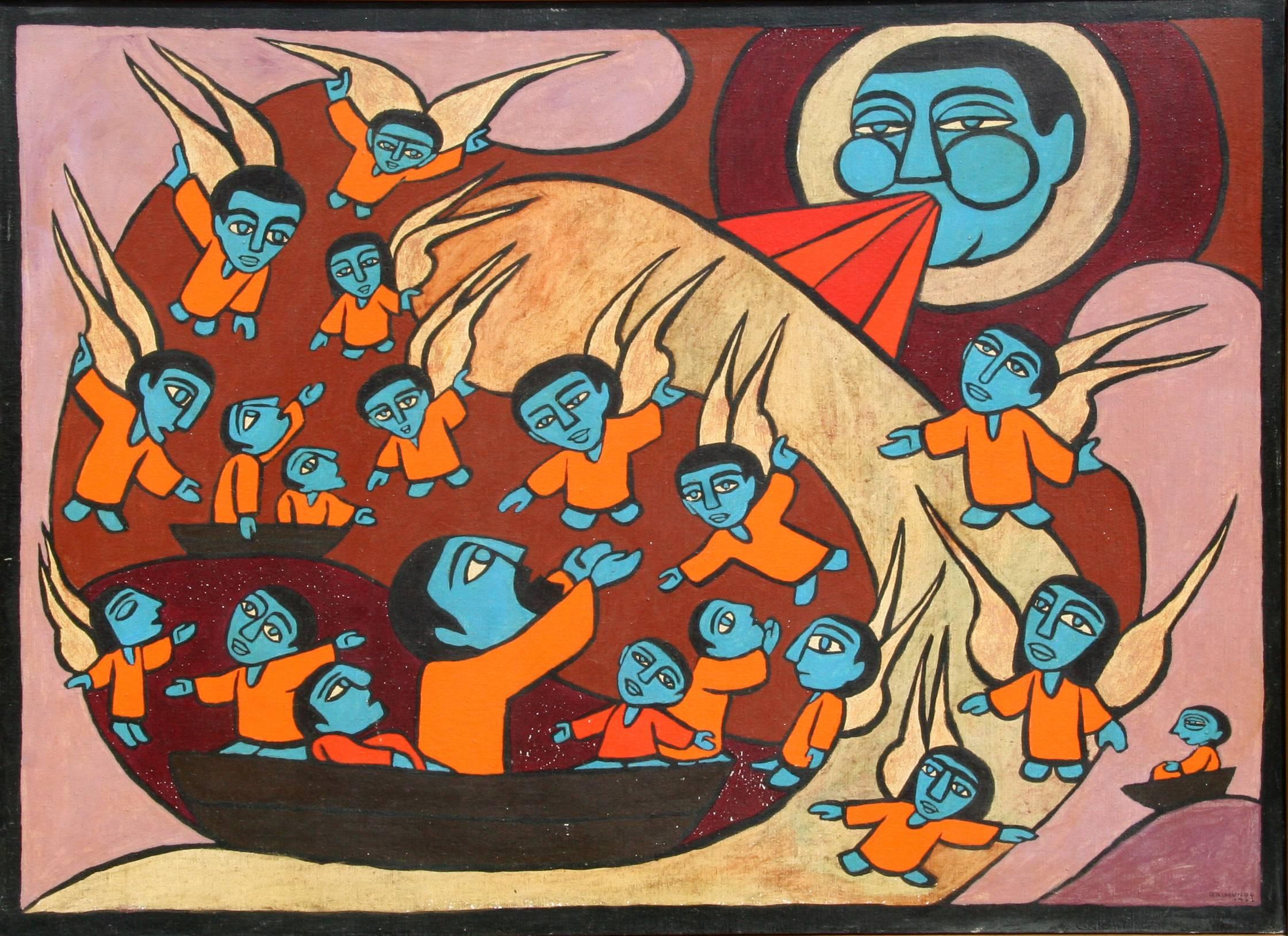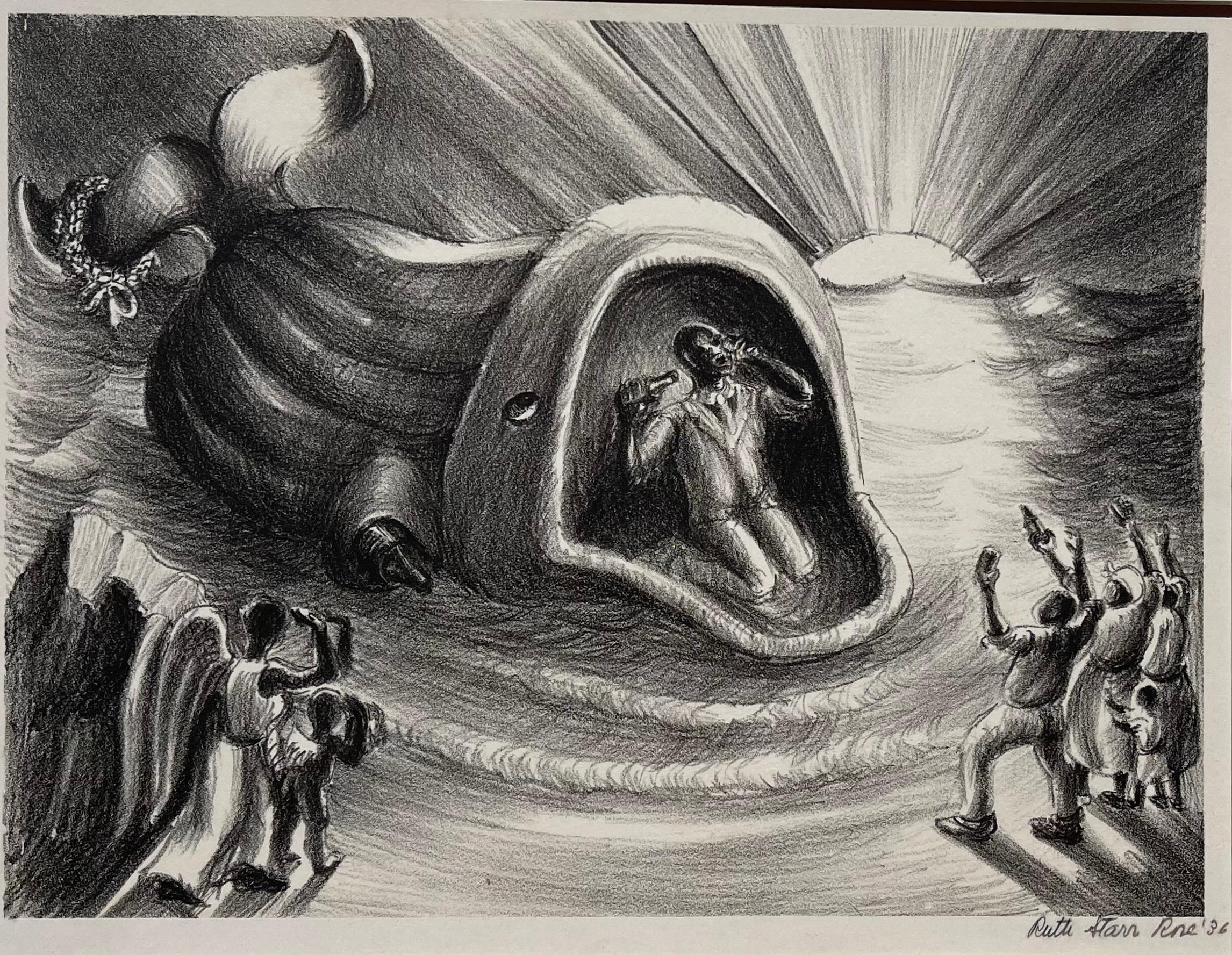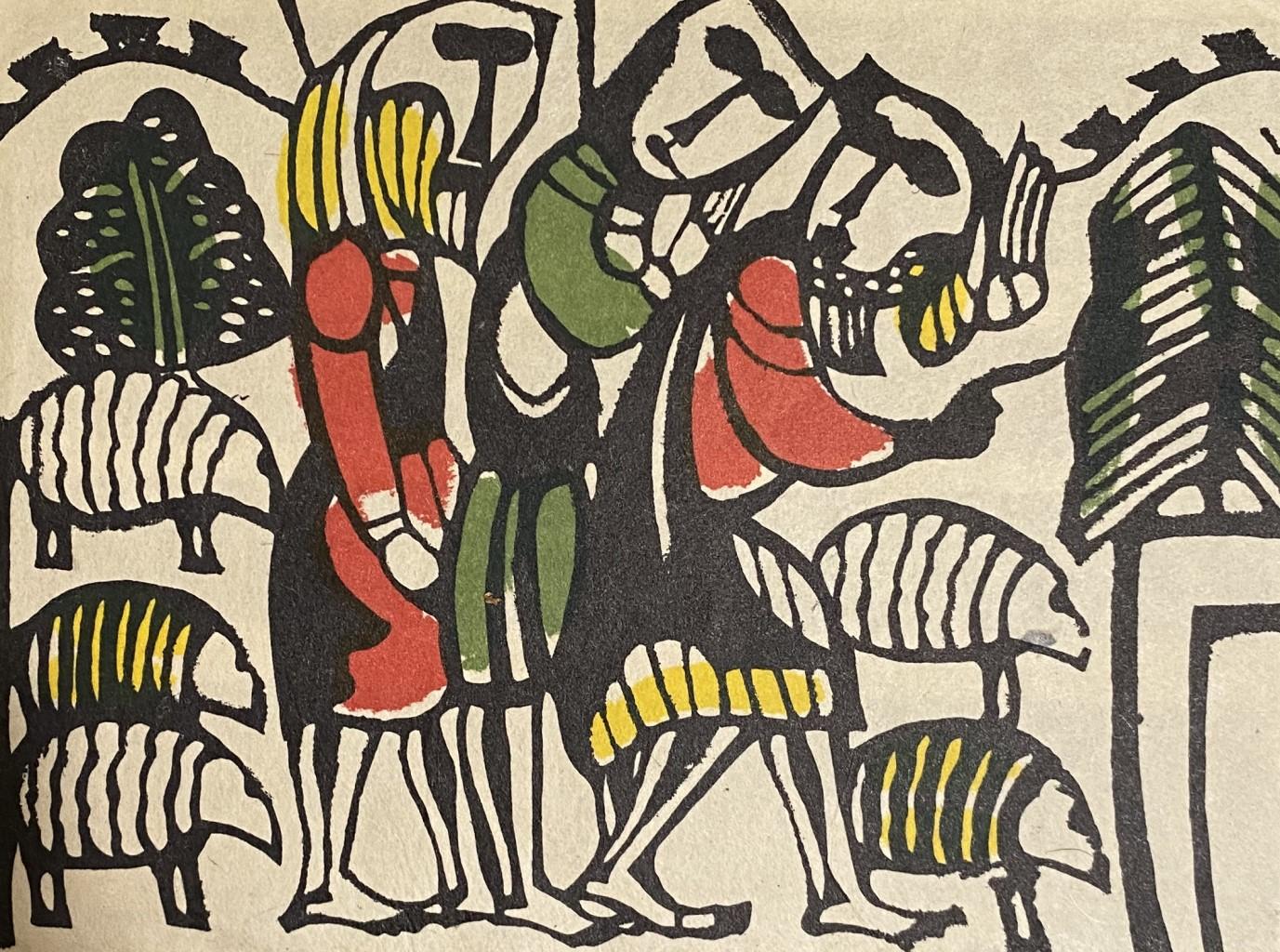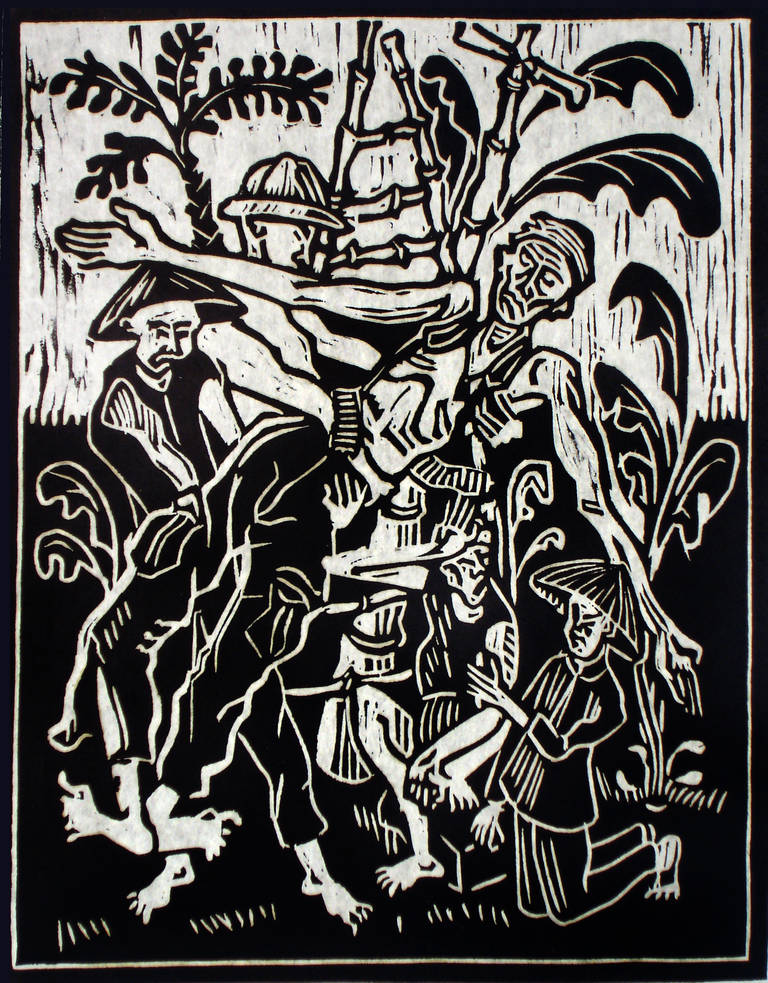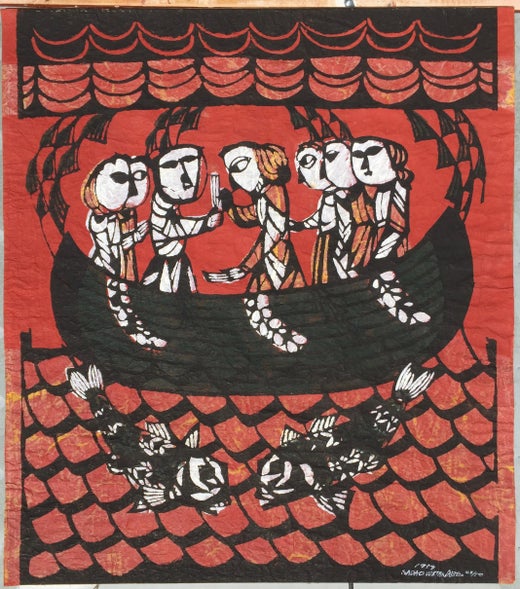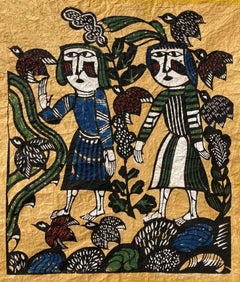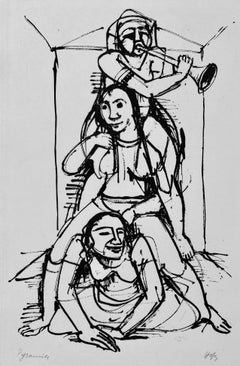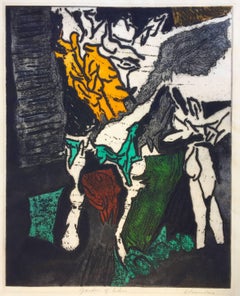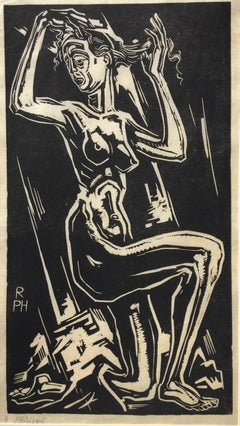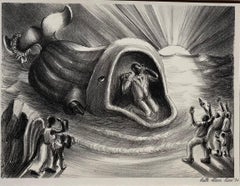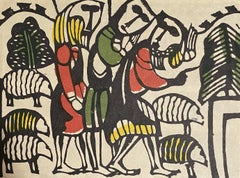Want more images or videos?
Request additional images or videos from the seller
1 of 11
Sadao WatanabeJonah1959
1959
$1,200
$1,50020% Off
£935.03
£1,168.7920% Off
€1,060.77
€1,325.9620% Off
CA$1,724.67
CA$2,155.8420% Off
A$1,899.03
A$2,373.7820% Off
CHF 984.73
CHF 1,230.9120% Off
MX$22,489.71
MX$28,112.1320% Off
NOK 12,500.50
NOK 15,625.6320% Off
SEK 11,683.14
SEK 14,603.9220% Off
DKK 7,922.67
DKK 9,903.3320% Off
About the Item
SADAO WATANABE (Japanese 1913-1996)
JONAH, 1959
Color stencil, signed, numbered and dated in white ink. Sheet, 25 5/8 x 22 5/8 inches. Edition: 44/50. Good color and generally good condition. Publisher: self published. Color stencil on hand crumpled momigami paper.
A classic Old Testament tale by Watanabe. It depicts the crew drawing straws to see which of them had offended the gods and caused this terrible storm; and Jonah drew the short one, destined to be thrown into the sea
From "The Living Bible":
The Lord sent this message to Jonah, the son of Amittai:
“Go to the great city of Nineveh, and give them this announcement from the Lord: ‘I am going to destroy you, for your wickedness rises before me; it smells to highest heaven.’”
But Jonah was afraid to go and ran away from the Lord. He went down to the seacoast, to the port of Joppa, where he found a ship leaving for Tarshish. He bought a ticket, went on board, and climbed down into the dark hold of the ship to hide there from the Lord.
But as the ship was sailing along, suddenly the Lord flung a terrific wind over the sea, causing a great storm that threatened to send them to the bottom. 5 Fearing for their lives, the desperate sailors shouted to their gods for help and threw the cargo overboard to lighten the ship. And all this time Jonah was sound asleep down in the hold.
So the captain went down after him. “What do you mean,” he roared, “sleeping at a time like this? Get up and cry to your god, and see if he will have mercy on us and save us!”
Then the crew decided to draw straws to see which of them had offended the gods and caused this terrible storm; and Jonah drew the short one.
What have you done,” they asked, “to bring this awful storm upon us? Who are you? What is your work? What country are you from? What is your nationality?”
And he said, “I am a Jew;[a] I worship Jehovah, the God of heaven, who made the earth and sea.” Then he told them he was running away from the Lord.
The men were terribly frightened when they heard this. “Oh, why did you do it?” they shouted. 11 “What should we do to you to stop the storm?” For it was getting worse and worse.
Throw me out into the sea,” he said, “and it will become calm again. For I know this terrible storm has come because of me.
They tried harder to row the boat ashore, but couldn’t make it. The storm was too fierce to fight against. 14 Then they shouted out a prayer to Jehovah, Jonah’s God. “O Jehovah,” they pleaded, “don’t make us die for this man’s sin, and don’t hold us responsible for his death, for it is not our fault—you have sent this storm upon him for your own good reasons.
Then they picked up Jonah and threw him overboard into the raging sea—and the storm stopped!
The men stood there in awe before Jehovah, and they sacrificed to him and vowed to serve him.
Now the Lord had arranged for a great fish to swallow Jonah. And Jonah was inside the fish three days and three nights.
- Creator:Sadao Watanabe (1913 - 1998, Japanese)
- Creation Year:1959
- Dimensions:Height: 25.625 in (65.09 cm)Width: 22.625 in (57.47 cm)
- Medium:
- Movement & Style:
- Period:
- Condition:
- Gallery Location:Santa Monica, CA
- Reference Number:1stDibs: LU41138606552
Sadao Watanabe
Sadao Watanabe, born in Tokyo in 1913, used the medium called kappazuri ("stencil printing"), a technique related to 'katazome' ("stencil dyeing"). 'Katazome' is said to have originated in Okinawa (the method there was called 'bingata'). The paper most widely used in Japan for stencil printing is called 'shibugami', made from several layers of 'kozo' paper laminated with persimmon tannin. The sheets are dried and smoke-cured to strengthen them and make them flexible and waterproof. Once the artist makes a drawing, it is fixed to the 'shibugami' with a thin adhesive. The basic pattern is then carved into a "key impression" stencil (the equivalent to the keyblock in woodblock printing) called the 'omogata'. If colors will also be used for the final design, separate stencils are sometimes cut for each color. If the stencil pattern has thin lines they can be reinforced with silk gauze, which still allow for uniform printing of colors. The first stage of the printing process involves the application and drying of a dye-resist paste to cover all the portions of the design to be left unprinted by the design. The patterns and colors can then be brushed over the stencil while affecting only those areas without resist paste. Typically the first colors printed are the lighter areas so that darker colors can be overprinted. After all the colors are printed and dried, the key impression stencil is finally used to print the key design over all the previous colors. The dye resist paste is then washed off (called 'mizumoto', "to wash by water") and the paper is dried on a wood board. Watanabe typically printed on a colored ground, so he would first apply a color to the paper. Watanabe, who was baptized a Christian in 1930, based his designs exclusively on Biblical subjects, though his Christian stories and figures are interpreted through a filter of traditional Japanese techniques and even some older Buddhist figure prints. The folk-art movement in Japan began in the 1930s as an attempt to keep alive various traditional arts, among them stencil printing. Watanabe was an early member of a small but important group of artists who dedicated themselves to learning and preserving these arts. Watanabe's emotioonally moving Biblical prints are have been popular throughout the world, and have been hung in the Vatican, the White House, in museums and in private collections.
About the Seller
5.0
Recognized Seller
These prestigious sellers are industry leaders and represent the highest echelon for item quality and design.
Platinum Seller
Premium sellers with a 4.7+ rating and 24-hour response times
Established in 1977
1stDibs seller since 2016
296 sales on 1stDibs
Typical response time: 1 hour
Associations
International Fine Print Dealers Association
- ShippingRetrieving quote...Shipping from: Santa Monica, CA
- Return Policy
More From This Seller
View AllGIRLS WITH LOTS OF QUAILS
By Sadao Watanabe
Located in Santa Monica, CA
SADAO WATANABE (Japanese 1913-1996)
GIRLS WITH LOTS OF QUAILS, 1965
鶉と少女
Hand colored stencil print on momigami textured paper. Signed and numbered in white. Edition 50, Image 17 x 2...
Category
1960s Modern Figurative Prints
Materials
Stencil
$1,150 Sale Price
23% Off
PYRAMID
Located in Santa Monica, CA
KARL HOFER / Carl Hofer (German 1878-1955)
PYRAMID, 1924
Lithograph, signed and titled in pencil. Unknown edition but small. Image 15 1/2 x 10, sheet 18 1/...
Category
1920s Modern Figurative Prints
Materials
Lithograph
Garden of Eden
By Leonard Edmondson
Located in Santa Monica, CA
LEONARD EDMONDSON (1906 – 2001)
GARDEN OF EDEN c. 1960
Color intaglio (carborundum?) Signed and titled in pencil. Small edition, these larger prints...
Category
1960s Abstract Expressionist Abstract Prints
Materials
Intaglio
$750 Sale Price
37% Off
AGONY
Located in Santa Monica, CA
ROBERT PHILIPPI (Austrian 1877-1959)
KNEELING NUDE. c. 1923 (Chrastek, Widder 2019, p. 162, N° 461) (in Rifkind Collection, LACMA: From a portfolio of 1...
Category
1920s Expressionist Figurative Prints
Materials
Woodcut
$600 Sale Price
20% Off
Phantasy
By Carl Hoeckner
Located in Santa Monica, CA
CARL HOECKNER (1883 – 1972)
PHANTASY c 1935 Lithograph edition unknown, but rare. Slight glue stain
upper margin. 10 ½” x 15 ¾” ...
Category
1930s Surrealist Figurative Prints
Materials
Lithograph
$750 Sale Price
23% Off
KYOTO (B)
By Kiyoshi Saitō
Located in Santa Monica, CA
KIYOSHI SAITO (Japanese 1907 - 1997)
KYOTO (B) 1966
Color woodcut, signed, titled, dated and no. 5/100 in pencil. Edition 100. Image 14 3/4 x 20 5/8 inches. Full margins with deckle...
Category
1960s Modern Landscape Prints
Materials
Woodcut, Color
You May Also Like
Jonah on the Way
Located in San Francisco, CA
This artwork titled "Jonah on the Way" 1975, is an original colors wood block print on thin paper by noted Austrian artist Bernd Kroeber, b.1942. It is hans signed, titled, dated and...
Category
Late 20th Century Surrealist Figurative Prints
Materials
Woodcut
Jonah and the Whale
By Raimundo de Oliveira
Located in Long Island City, NY
Artist: Raimundo de Oliveira, Brazilian (1930 - 1966)
Title: Jonah and the Whale
Year: 1962
Medium: Oil on Canvas, signed and dated l.r.
Size: ...
Category
1960s Contemporary Figurative Paintings
Materials
Canvas, Oil
Price Upon Request
JONAH AND THE WHALE
By Ruth Starr Rose
Located in Portland, ME
Rose, Ruth Starr (American, 1887-1965). JONAH AND THE WHALE. Lithograph, 1936.
Edition size not known.
Titled, signed and dated in pencil. Printe...
Category
1930s Figurative Prints
Materials
Lithograph
Surreal Composit - Woodcut by Sadao Watanabe - 20th Century
By Sadao Watanabe
Located in Roma, IT
Surreal Composit is an original woodcut, hand colored, on paper realized by Sadao Watanabe for College Women's Association of Japan Student Travel grant fund.
Specially woodcut wit...
Category
20th Century Modern Abstract Prints
Materials
Woodcut
$494 Sale Price
30% Off
Sacrifice
By Don Schol
Located in Denton, TX
Edition of 8
Signed, titled and numbered
From the series: Vietnam Remembrances
After receiving his MFA at the University of Texas in 1966, Don Schol was drafted into the Army and be...
Category
21st Century and Contemporary Contemporary Figurative Prints
Materials
Woodcut
$1,500
Invitation to the Paradise #11
Located in San Francisco, CA
Artist: Sakurai Takami - Japanese (1928-2016)
Title: Invitation to the Paradise ST#11
Year: circa 1972
Medium: Oil on Canvas
Sight size: 18 x 24 inches.
Framed size: 21 x 27 inches
Signature: Unsigned. Label on old frame
Condition: Very good
Frame: Framed in original frame. Frame in poor condition
This oil on canvas is by the noted avant garde Japanese artist Sakurai Takami (1928-2016). It was created sometime between 1971, when Takami lived in San Francisco and was a member of and exhibited with the “Konnyaku Commune” and 1978 when he exhibited with the Vorpal Gallery in San Francisco. This painting was purchased from the Vorpal Gallery. The painting is in very good condition. It is unsigned, but the title is on the side of the metal frame. The frame is fine, but the mat is stained and in poor condition. I will include the frame for protection and provenance.
Sakurai was a main member of the avant-garde art group “Kyushu-ha”. Kyushu-ha” created a major trend among contemporary art in post-war Japan, which spread from Fukuoka to the whole country and also France, the United States and other overseas countries. Throughout his life he was very dramatic; his enormous and diverse works are energetic and face us with the true meaning of expression. Initially his main focus was on informal paintings, but it gradually expanded towards anti-artistic objects and performances. His works are characterized by the usage of materials that are connected with the smell of a workers life, such as coal tar, asphalt, woven mats and dungarees (jute bag).
Shortly after Kyushu-ha disbanded in 1968, Sakurai Takami moved to San Francisco. From 1973 onward, he lived in France. The people and faces in Sakurai’s paintings are coloured red, so that the colour, a symbol of heat, becomes a “social sign”. Each person has a life of their own, while at the same time expressing the colourful life of human communities, like the hippies.
His theme may be drawing “humanity and the universe” with a loving embrace of “peace” and “life”.
1953 graduated Fukuoka Liberal Arts University
1955 40th Nika Art Exhibition, Tokyo Metropolitan Art Museum
1956 Persona Exhibition, outer west side of the Fukuoka prefectural office
1957-68 part of Kyushu-ha
1965 went to the United States (~’67)
1970 “Kanousei e no Ishi“ Kitakyushu Hachiman Museum of Art
Kyushu: Trends in Japanese Contemporary Art Exhibition, Fukuoka Bunka Hall
Sakurai Takami solo exhibition, Fukuoka Bunka Hall
went to the United States for the second time, started working with the konyaku commune (San Francisco)
1971 Konyaku Revolution Art Exhibition (San Francisco)
1973 Nagoya mayor nominating election convention, Azabu public hall
moved to France
1974 formed the group “Kusuguri” (Paris)
1975 7th...
Category
1970s Other Art Style Figurative Paintings
Materials
Canvas, Oil
